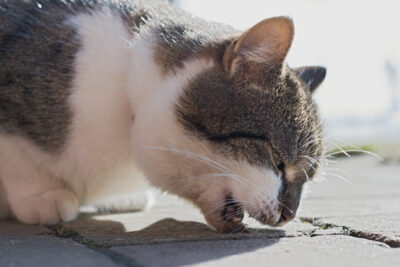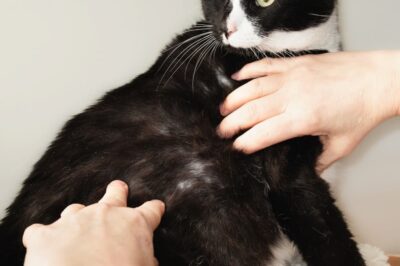Lumps on Cats: Types and What They Mean

All featured products are chosen at the discretion of the GreatPetCare editorial team and do not reflect a direct endorsement by the author or reviewer.
Discovering a lump on your cat can be a scary experience. Not all lumps on cats are cancerous, but many do need veterinary attention and intervention. So always schedule an appointment with your veterinarian if you find a worrisome lump on your cat.
However, learning more about lumps on cats is always a good idea. It may not eliminate your worry entirely, but it can help you know what to watch out for…and what to do about it!
Here we will discuss various types of lumps and bumps on cats, specific characteristics of each type, what to do if you find one on your cat, and what they mean for your cat’s overall health and prognosis.
Lumps on Cats: Don’t Panic
Most cat parents are likely to encounter a lump or two on their cat’s skin over the course of their lifetime. And the likelihood increases as your kitty gets older. While lumps on cats can be found in felines of all ages, they are more common among senior cats.
There are various types of skin lumps in cats, ranging from minor skin infections to more serious conditions like cat skin cancer.
Skin tumors in cats are relatively common. These can be classified as benign (non-cancerous) or malignant (cancerous). Less than 5 percent of lumps and bumps in cats arise from the skin. [1] However, just over half of these cat skin lumps are considered cancerous.
Finding a lump on a cat does not necessarily mean the worst, but it is crucial to have a vet evaluate it to ensure a proper diagnosis and treatment plan.
Types of Lumps on Cats

Lumps on cats vary in size, feel, and appearance. Let’s discuss a few of the most common types of cat skin tumors and their corresponding characteristics.
Lipomas: Also known as feline lipomas or fatty tumors on cats, these non-cancerous skin tumors are made up of feline fatty tissue. This gives them a soft, movable feeling when pressed. These fatty tumors are generally spherical and can be various sizes. Cat lipomas can be found anywhere on their body but are most common on the abdomen, upper legs, back, and neck.
Lipomas do not generally affect a cat’s health. However, if they develop near the legs they can restrict movement if they grow too large.
Sebaceous cysts: These benign cat cysts are small to medium in size and irregularly shaped. They are firm to the touch and contain a thick, white material inside. Sebaceous cysts in cats are usually found on the head, neck, chest, and sides of the body. Cats with this type of lump generally have a good prognosis.
Abscess: These non-cancerous lumps can vary greatly in size. But they all tend to be smooth and spherical in shape. They contain a white material called pus and sometimes blood. Cat abscesses often develop secondary to bites or wounds. They are particularly common on the back, neck, and legs.
Soft tissue sarcoma: These cancerous lumps are typically firm and can vary in shape from round to irregular. Soft tissue sarcomas are generally found on the legs, back, chest, and mouth. The prognosis can vary depending on their location and treatment.
Warts: These small, non-cancerous lumps are firm to the touch and typically round, though some may be irregular in shape. Cat warts are most common on the head, face, legs, and neck. They tend to remain small and generally have a good prognosis.
Basal cell tumors: These dark, firm lumps on cats are often raised above the skin and vary in size. They are non-cancerous but can grow quickly. They can be found anywhere on a cat’s body. Although they are not cancerous, some types of basal cell tumors can cause severe inflammation and pain.
Fibrosarcomas: These highly common, cancerous cat tumors vary in size and shape, and they are firm to the touch. Such tumors can develop following vaccination in some cats. Even when surgically removed, they often come back. The prognosis for affected cats is guarded-to-poor.
Squamous cell carcinoma: This type of cat skin cancer often affects a cat’s mouth. It can also be found anywhere on their skin, especially in sun-exposed areas. Lumps vary in size and shape and often appear red or crusted. The prognosis is typically poor without early detection and treatment.
Mast cell tumor: These are common cat skin lumps found primarily on the head and neck. They are typically raised, hairless lumps that may itch. While most are benign, some can become cancerous. In that case, the prognosis becomes poorer.
Diagnosing Lumps on Cats
A veterinarian will start with a thorough physical exam, checking all parts of your cat’s skin. Some lumps, like warts or skin tags on cats, may be identified by appearance. However, further testing is often needed to determine the type of lump and appropriate treatment (especially if the lump is cancerous).
Testing may include the following:
- Fine Needle Aspirate (FNA): A veterinarian uses a small needle to collect cells from the lump. These may be examined under a microscope or sent to a lab for identification.
- Skin Biopsy: A portion of the lump is surgically removed and analyzed by a pathologist to determine the diagnosis and prognosis.
- Bloodwork: Checking a cat’s blood helps assess overall health and organ function, which is especially critical before surgery.
- Imaging: Tests, such as radiographs (x-rays) and ultrasound, can help determine if a cancerous lump on a cat has spread elsewhere in the body.
Treating Lumps on Cats

Treatment depends on the type and severity of the lump. Possible treatment options for cats may include:
- Surgery: In some cases, surgery is necessary to remove large or cancerous skin lumps on cats or protrusions that interfere with mobility.
- Drainage: Abscesses and cysts may be drained with a needed and cleaned.
- Topical medication: In some cases, topical anti-inflammatory or antibiotic medication may be prescribed to reduce the size of the lump before surgery or help to resolve it altogether.
- Oral medication: Anti-inflammatories like Onsior can reduce pain and inflammation associated with skin lumps. Oral antibiotics like Clavamox may be prescribed, especially for cat abscesses.


- No treatment: Sometimes, a skin lump will regress on its own. Benign lumps may be simply monitored for changes in appearance and size.
Finding a lump on your cat can be alarming, but not all lumps are cause for concern. Many are benign and easily treated. However, because some lumps can be cancerous, it’s important to have any new bump checked by your veterinarian.
Early diagnosis can lead to better outcomes. Whether it’s a soft fatty tumor, a firm cyst, or something more serious, your vet can help guide the best course of action. Stay informed, stay observant, and don’t hesitate to seek veterinary care if your cat develops a lump.
REFERENCE:









